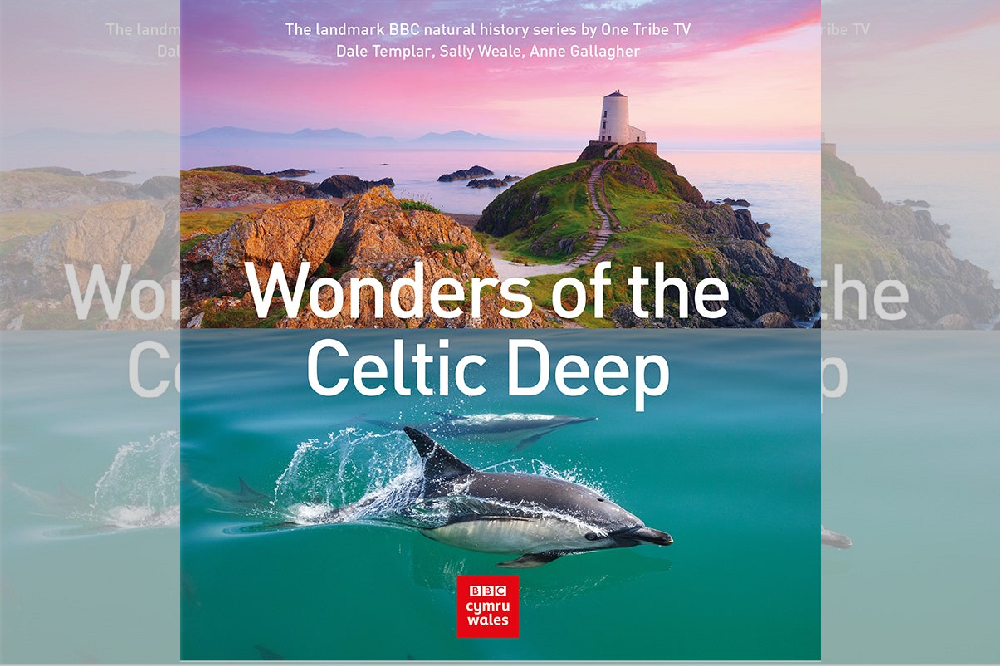Review: Wonders of the Celtic Deep

Dale Templar, Sally Weale, Anne Gallagher – published by Graffeg
Jon Gower
The opening image of this lavish celebration of the wildlife in Welsh waters is a compass jellyfish, drifting elegantly across a two-page spread. It’s body, or bell is veined with orange-brown markings – arranged very much like the compass in its name – and trailing a long, fine tentacles behind it through the water. It’s just one of the many privileged glimpses of the marine world arrayed within its pages, which make it a visual delight.
In part the book is a how-we-did-it account, by the team at One Tribe TV, of assembling the landmark BBC natural history series, with all the challenges of underwater filming against the vagaries of the weather, the state of the swell and the seasonality of its subject matter. The team only had a year to make the series, which would have been difficult enough without Covid changing all the rules, and forcing the filming team to keep to a bubble in a dilapidated farmhouse like something out of Withnail and I.
The Director of Photography Rob Taylor suggested that the place was ‘only habitable if you’d spent time living in the Peruvian jungle.’ Taylor also had to contend with the fact that filming windows were often small, and many closed peremptorily as local authorities denied access to choice locations. Not to mention the simple inaccessibility of some of those places anyway. Try to get your camera to the remote Smalls lighthouse and then keep your equipment dry.
Visual feast
But the resulting visual feast of a series was well worth it, and the book reminds us of the many underwater wonders they managed to array. There is the common blenny, a fish that breathes through a thin coating of slime rather than skin and the cuckoo wrasse, a blue and orange fish as tropical as any found in an aquarium and yet widespread around the Welsh coast.
The film-makers visited the noisy seabird city of South Stack on Anglesey, with its serried ranks of guillemots, arrayed precariously on its ledges. Here, in high summer the newly fledged birds, or ‘jumplings’ do just that, jumping into the sea by way of their first, nervous ‘flight.’
Then there were predators such as the small spotted catsharks, moving like miniature torpedoes through the kelp forests off the coast. And leviathans, too – such as the 25 metre long fin whales – which submarine alongside species as minke whales and blue sharks, not to mention outsize leatherback turtles and Atlantic bluefin tuna, one of the fastest fish in the world. All these and more inhabit such places as the waters of St George’s Channel, between Wales and Ireland, and much further out into the Celtic Deep and the team were lucky enough to film so many of them, sometimes serendipitously and other because of very careful planning and the benefits of local expertise.
The closing section of the book is devoted to vignettes of ‘Heroes of the Celtic Deep’ including members of ‘Project Seagrass’ such as Swansea university lecturer Richard Unsworth, actively creating underwater meadows of eelgrass, with all their attendant biodiversity and scuba diving litter-pickers such as Pembrokeshire plumber David Kennard.
We meet young citizen scientists such as Aaron Lock, who studies and logs the wildlife of the intertidal zone and Frankie Hobro from the Anglesey Sea Zoo, who is helping save the two threatened seahorse species found in our shallow waters. Then there is paddleboarder and campaigner against single-use plastics Sian Sykes, who alerts us to the pernicious presence of plastics. This has resulted in seabirds such as the majority of fulmars carrying plastic around in their stomachs and wildlife of all sizes sometimes starving to death as a consequence of their stomachs being crammed full of the stuff.
One of the pleasures of armchair nature-watching as allowed by perusing the pages of ‘Wonders of the Celtic Deep’ is the opportunity to learn about species you might not even have heard about before and to explore the complexities of their lives. There is the painted goby, for instance, that takes up residence in an abandoned shell, which it then defends most fiercely by raising an ice-blue fin against all-comers. The fin also generates drumbeats as if the little fish was starting a war against any small rival on the seabed. And then there is the golf-ball sized, huge-eyed Atlantic bobtail squid, which can emit light at exactly the same wavelength as the moon. A lustrous fact if ever there were.
The book is a fitting celebration of these species and many more, as well as offering a quiet salute to the passionate film-makers who ventured by kayak and canoe and donned scuba gear to visit places few of us will ever see. Sometimes they went free-diving, holding their breath to get close to the wildlife around ship wrecks, rocky islets or in open sea. In so doing they have reminded us that sunfish and dolphins, horse mussels and basking sharks are as much a part of our Welsh wildlife heritage as red kites and Snowdon lilies. They also need the same sort of protection, else they be lost, and, with that leave our world of glorious, compelling complexity that much more diminished.
Wonders of the Celtic Deep is published by Graffeg. You can buy a copy here…
Support our Nation today
For the price of a cup of coffee a month you can help us create an independent, not-for-profit, national news service for the people of Wales, by the people of Wales.





